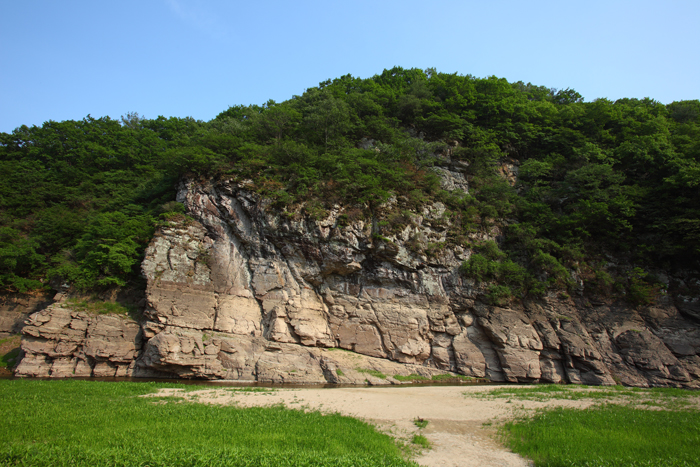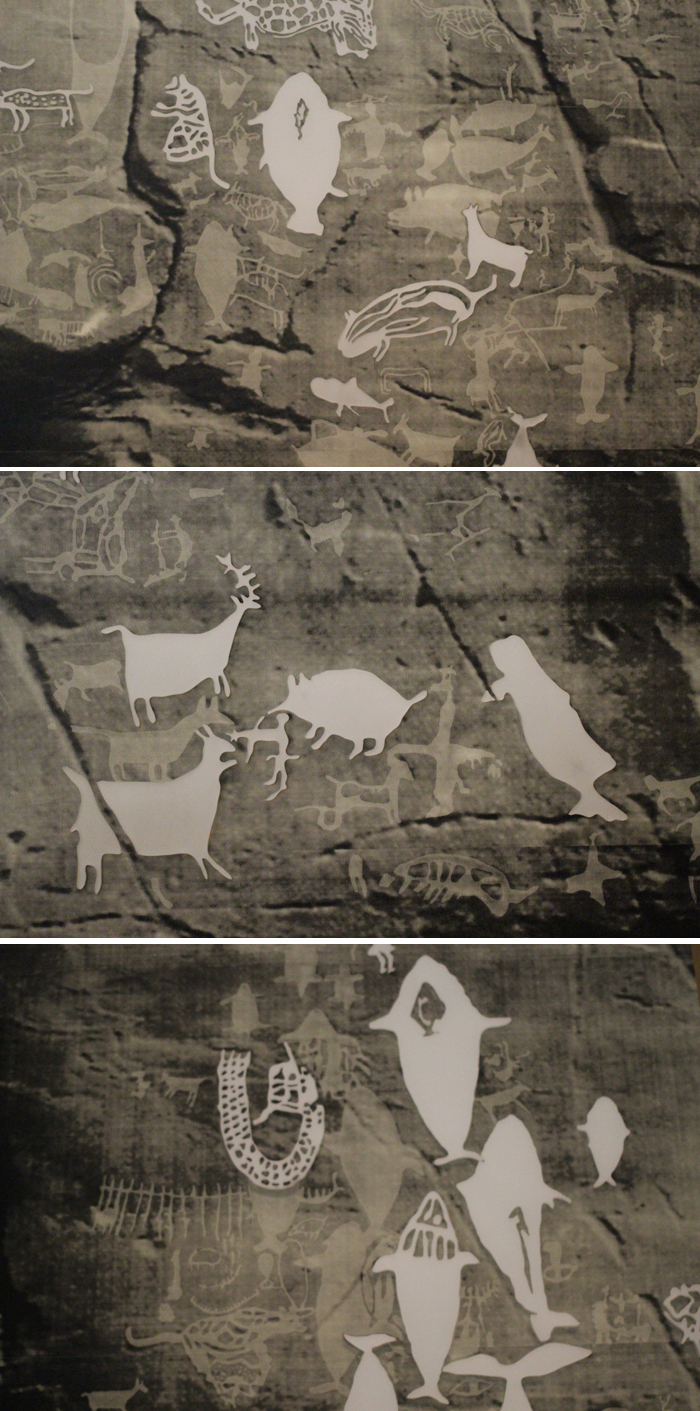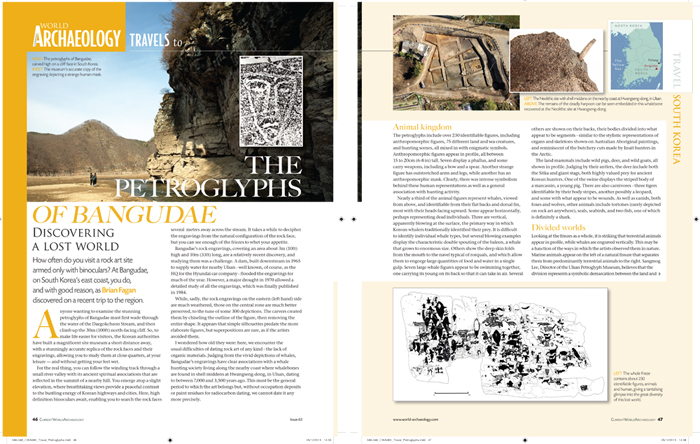Numerous ancient rock engravings of whales and whaling still remain in the southeast area of the Korea Peninsula, attracting archeologists from around the world. It has been suggested that they are the first pieces of evidence showing the prehistoric origins of whaling. These petroglyphs are found in Bangudae in the upper reaches of the Taehwagang River near Ulsan in Gyeongsangbuk-do (North Gyeongsang Province). Nearly 300 figures showing land and sea animals, as well as whale-hunting scenes, are found engraved into the wall over an area spanning 10 meters by 3 meters.
The name Bangudae comes from the Korean ban, the word for a carapace or a shell, gu, meaning a turtle, and dae, a structure or a site, as in a carving site; the rock formation itself is said to resemble the back of a turtle.
The petroglyphs of Bangudae recently came under the spotlight with the February edition of Current World Archaeology, a U.K.-based magazine devoted to archaeological finds. Based on his visit to Bangudae, archeologist professor Brian Fagan published a three-page article, “Discovering a Lost World,” in which he relates his observations about the engravings.
He concluded his article by saying, “The Bangudae engravings remind us of the remarkable skills of such ancient whale hunters, who attacked the world’s largest beasts with the simplest of weapons, relying on their knowledge of their prey and acute observational skills, as well as complex, now forgotten, rituals that provided powerful validation for the chase.”

The petroglyphs of Bangudae were discovered in 1971. The figures engraved on the rock wall include humans, various types of animals—whales, turtles, deer, tigers, birds and pigs—and weapons, including a bow and a spear. Researchers believe that the engravings were completed over several centuries, from the Neolithic to the Bronze Age. Among these are 58 engravings of whales and whaling that have attracted the most attention. The petroglyphs show a diverse range of whales, including one that’s bearing a calf. Researchers believe them to symbolize an active hunting culture, prosperity and abundance. Along with the figures, whale hunting skills are shown in the ancient works of art, too.
Until the discovery of Bangudae, it was believed that whaling began in Norway in around 4,000 B.C., according to the rock carvings in the Norwegian town of Alta. However, in 2004, the BBC reported that, “Stone Age people may have started hunting whales as early as 6,000 B.C., new evidence from South Korea suggests.” This grabbed the attention of media and archeologists from across the globe.

Since their discovery, the petroglyphs of Bangudae have been considered an important resource that gives a peek into the values, ideas and religions of mankind from a time before recorded history began. Oceanographer Daniel Robineau, in his book, “Une Histoire de la chasse a la baleine,” or, “A History of Whale Hunting,” published in 2007, said that the first whale hunting began in Korea, as shown in the petroglyphs.
French archaeologist and film maker Marc Azéma said the Korean petroglyphs could have possibly been the inspiration for his concept of a movie in his book, "La Prehistoire du cinema,” or, “Cinema in Prehistoric Times.” In 2013, the rock carvings stepped into the spotlight again when the French journal Archeologie described the art work as a moving object, such as a movie or cartoon.

Director Lee Sang-mog of the Ulsan Petroglyph Museum said that there have been a number of requests to use the carvings over recent years. “A growing number of researchers and scholars seem to be studying the petroglyphs from a variety of perspectives, whether it be looking into the mythologies surrounding the artwork or whether it be its artistic merits.
By Lee Seung-ah
Korea.net Staff Writer
slee27@korea.kr
The name Bangudae comes from the Korean ban, the word for a carapace or a shell, gu, meaning a turtle, and dae, a structure or a site, as in a carving site; the rock formation itself is said to resemble the back of a turtle.
The petroglyphs of Bangudae recently came under the spotlight with the February edition of Current World Archaeology, a U.K.-based magazine devoted to archaeological finds. Based on his visit to Bangudae, archeologist professor Brian Fagan published a three-page article, “Discovering a Lost World,” in which he relates his observations about the engravings.
He concluded his article by saying, “The Bangudae engravings remind us of the remarkable skills of such ancient whale hunters, who attacked the world’s largest beasts with the simplest of weapons, relying on their knowledge of their prey and acute observational skills, as well as complex, now forgotten, rituals that provided powerful validation for the chase.”

The petroglyphs of Bangudae, engravings of around 300 figures, are a prehistoric cultural asset from the Neolithic Age, showing that the people who lived here mainly fished and hunted for a living. Being one of the rarer examples of prehistoric art, the engravings have attracted the attention of both the archeology and arts scenes. (photo: Yonhap News)
The petroglyphs of Bangudae were discovered in 1971. The figures engraved on the rock wall include humans, various types of animals—whales, turtles, deer, tigers, birds and pigs—and weapons, including a bow and a spear. Researchers believe that the engravings were completed over several centuries, from the Neolithic to the Bronze Age. Among these are 58 engravings of whales and whaling that have attracted the most attention. The petroglyphs show a diverse range of whales, including one that’s bearing a calf. Researchers believe them to symbolize an active hunting culture, prosperity and abundance. Along with the figures, whale hunting skills are shown in the ancient works of art, too.
Until the discovery of Bangudae, it was believed that whaling began in Norway in around 4,000 B.C., according to the rock carvings in the Norwegian town of Alta. However, in 2004, the BBC reported that, “Stone Age people may have started hunting whales as early as 6,000 B.C., new evidence from South Korea suggests.” This grabbed the attention of media and archeologists from across the globe.

The figures of animals can be seen in highlights of the petroglyphs of Bangudae.
Since their discovery, the petroglyphs of Bangudae have been considered an important resource that gives a peek into the values, ideas and religions of mankind from a time before recorded history began. Oceanographer Daniel Robineau, in his book, “Une Histoire de la chasse a la baleine,” or, “A History of Whale Hunting,” published in 2007, said that the first whale hunting began in Korea, as shown in the petroglyphs.
French archaeologist and film maker Marc Azéma said the Korean petroglyphs could have possibly been the inspiration for his concept of a movie in his book, "La Prehistoire du cinema,” or, “Cinema in Prehistoric Times.” In 2013, the rock carvings stepped into the spotlight again when the French journal Archeologie described the art work as a moving object, such as a movie or cartoon.

The February edition of Current World Archeology introduces the petroglyphs of Bangudae.
Director Lee Sang-mog of the Ulsan Petroglyph Museum said that there have been a number of requests to use the carvings over recent years. “A growing number of researchers and scholars seem to be studying the petroglyphs from a variety of perspectives, whether it be looking into the mythologies surrounding the artwork or whether it be its artistic merits.
By Lee Seung-ah
Korea.net Staff Writer
slee27@korea.kr
